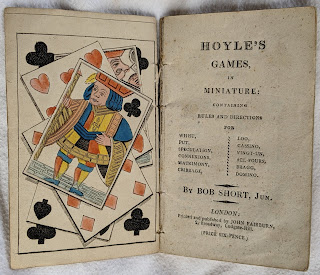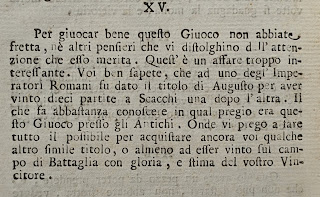A dozen books came my way this year--some condition upgrades, some of interest only to the Hoyle completist, plus a few gems. I'll discuss five of them in the order they were published.
The earliest acquisition is a third edition (1671) of Wits Interpreter: The English Parnassus. Most collectors want first editions, but I would not have been interested in the first (1655) or second (1662). The book collects love songs, poems, and dialogues from plays in reaction against the Cromwell revolution. With Charles II restored to the throne in 1660, the third edition included material on games, as highlighted in the preface:
I took advantage from this golden season...the golden age of His Majesties happy Restauration, from which all manner of Wit and Ingenuity received as it were a new birth, to add several Games and Sports, the most A la Mode and Curious, that are now in esteem among the Gentilest...Part 7 contains chapters on ombre, piquet, gleek, cribbage, and chess. Jessel observes that this book is the earliest that has come down to us with a treatise on card games, predating The Compleat Gamester (discussed here) by three years.
 |
| 1671 Wits Interpreter Levy [2175] |
My copy is in a luscious, extensively decorated morocco binding with the bookplate of Charles Tennant of The Glen in Scotland.
 |
| Bookplate of Charles Tennant |
There are two minor bibliographical oddities about the book. First, the title page identifies the author only as J. C. and the book it has universally been attributed to John Cotgrove, including by the ESTC. Joshua McEvilla recently demonstrated conclusively the the author is John Cragge in The Library, 18:3 337-344 (2017).
Second, there appear to be at least two versions of the third edition. Mine (like ESTC R2199) has the imprint "printed for N. Brook, at the Angel in Cornhill, and Obadiah Blagrave, at the Printing Press in Little Britain, MDCLXXI." Other copies (like ESTC R225554) omit the second line of the imprint. Moreover, at least one copy of the second issue ends on page 351, while other copies have a catchword at the bottom of 351 and the book continues through page 520. Library inquiries would be required to understand the variants I have seen in a small number of copies.
I purchased another copy of Games.5, the "fourteenth" edition of Mr. Hoyle's Games (1767). As I wrote in an earlier essay, some copies have a cancel title page, others the uncancelled page, and a couple have both. I found a copy with both title pages, crossing a completist variant off my list.
Also among my desiderata was the New York edition of Beaufort's Hoyle's Games Improved (1796). I found a Boston edition in 2014. When I purchased a Philadelphia edition in 2018, I wrote "Does anyone know where I can pick up the one sold in New York?" I got an email from a bookseller friend noting that another dealer had listed that book for sale and can now cross that off the list.
 | |
| Hoyle's Games Improved New York (1796) Levy [2180] |
The next item is not obviously by Hoyle, although the text is almost entirely his. It was first published in 1798 by H. D. Symonds. I noted an 1817 reprint by John Harris in an essay on eighteenth century backgammon literature. I bought an earlier Harris edition (1801) at auction.
 |
| 1801 Rules and Directions for Backgammon Levy [2177] |
 |
| 1801 Rules and Directions for Backgammon |
The last book came from an annoyingly mixed lot at auction, consisting of a Compleat Gamester worth thousands, a signed Hoyle (which I had) worth hundreds, and a later obscure Hoyle worth not very much. The obscure Hoyle is an 1820 reissue of a book first published in 1808 with a cancel title, although why it got reissued I cannot say. The book is rare, with copies recorded at Cleveland Public, Louisiana State, and Vanderbilt. Great rarity does not always mean great value.
 |
| 1820 The New Pocket Hoyle Levy [2181] |
I was not willing to bid anywhere near enough to be competitive on the lot, but I tried an approach that is usually unsuccessful. I wrote the auction house and told them of my interest in the least of the books and asked them to pass my name onto the winning bidder. They did so and I heard back from the winning buyer, a bookseller I know casually, and he was delighted to sell me the book for a modest price. A happy ending, and another to cross off my list.
Best wishes for a happy 2023!





















